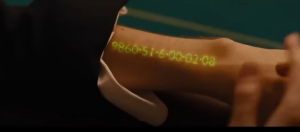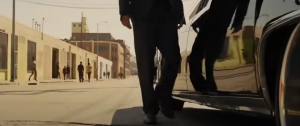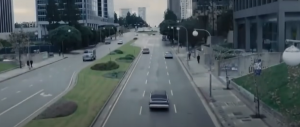61 In Time (2011)
“Economic Class Issue Representation: In Time (2011)”
by Jacob Frey
Most people are familiar with the hierarchical systems of ancient civilizations (Servants, Artisans, Nobles, Kings, etc.), but are unaware that these same systems still exist. These main modern hierarchical systems today are: Lower class, Middle Class, and Upper Class. These classes and the issues surrounding them are caused by the abuse of capitalism, distribution of wealth among the population, and the machinations of those in power. Capitalist businesses, whose sole purpose is to amass wealth, want to maximize profits and reduce costs by a “time is money” philosophy, where they view the time, or working hours, with a numerical, monetary value. To maximize profit, they either pay little per hour, or run as few people as possible and extort for a maximum amount of work, usually both, much to the detriment of the employees.
Now, what does all this pertain to the movie In Time (2011)? The film takes the philosophy “Time is money” and takes it to the extreme by making it very literal. In the setting of the film, humans are genetically engineered to stop aging past the age of 25. However, a clock on their forearm starts counting down with a year left to live. Their time is the currency of the world. The population must work to earn more time, and pay time for necessities like shelter and food or luxuries like cars and gambling. Moreover, the class system is also taken to the extreme, dividing each class level with physical walls dividing the country into time zones. Barriers that require payment to move up the class hierarchy. The main protagonist; Will Salas, was born and raised in the ghetto, living day to day in the lower class until he comes across a benefactor who gave him 100 years of time.

There are two specific scenes in the movie that showcase the oppression and class difference resulting from the economic system, one visually and one ideologically. The first one is a series of shots as the main protagonist travels between the time zones. The scene starts with a low shot of the vehicle Will is getting into, the background showing the basic architecture and buildings with bars on the windows, dirty unkempt roads and people wandering about to show a less than ideal neighborhood. Outside the movie, the filming of this setting was done at the Skid Row and Boyle Heights neighborhoods of Los Angeles.

.
The next several shots show him passing concrete road blockades each with a different time zone number while focusing on the car and the occupant. When Will reaches his destination, the camera pans out overhead to a top down wide shot of skyscrapers, green lawns and well maintained roads. This shot indicates a much nicer, richer neighborhood in the time zone where the rich reside called New Greenwich, filmed in areas like Malibu, Bel Air and Century City California. The people here live in luxury while others live in slums.

The second scene, probably the best in the film, is the Casino scene. After arriving in New Greenwich, Will decides to go to a lavish, opulent casino and joins in on a no-limit poker game with the pot currently at 600 years. Will’s demeanor and way he carries himself is picked up on by Philipe Weiss, the main antagonist and owner of Weiss Banking, as someone not from the area.
Their conversation turns to the economic system and the use of time as currency. The dialogue between the characters discussed the world’s time system. When discussing how unfair the differences of wealth and power between the time zones are, the antagonist states the system as “the next logical step in evolution”(Philipe Weis, In Time 00:31:24) and that evolution is unfair. Tying Capitalism to Darwinism and natural selection. Phillipe praised the system as Darwinian Capitalism since those who are unable to earn their time, die.
While in reality we won’t die if we run out of money, the movies make extreme the actual issues with difference and power in the economic class system. From low income families unable to make ends meet, homelessness, and middle-class families drowning in debt as the price of goods increase while their income does not keep up with inflation. To the wealthy like Jeff Bezos spending their money lavishly like a recreational space flight, or worse, using the power their money yields to oppress the lower economic classes in politics.
The wellness and survival of humans in modern day society is dependent on how much money they can accumulate to make ends meet, and fulfillment comes from having enough money to enjoy life. So while in the movie people die when their bank account reaches zero, it’s parallel to reality as having no money can lead to starvation, loss of livelihood, and even death in extreme circumstances.
The movie In Time (2011) firmly places the idea that economic class and the struggles they cause are a result of one of the fallacies of Capitalism. “The socio-economic and political basis of this film rests on some of the key points of Marxist ideas. Though, the question remains, whether this film is a dedicated Marxist film or not”(Zaman In time: Story of exploitation and class struggle). Karl Marx’s views on social classes are identified based on two points: ownership of production and control over the labor of others.
While there are many different social classes Marx identified within the capitalist mode of production, the movie focuses on two of them. The most prominent of these is the Bourgeoisie, “they get the most benefit of the production, this can be happened because they are the owner of production property, and ruling whoever works for them.”(Octian Pg 15) and the Proletariat, “they are the owners of labor power (the ability to work, with no resource other than the ability to work with their physics and minds. In other word, they are exploited by the Bourgeoisie to make a profit from the Bourgeoisie’s property” (Octian Pg16)
The inefficiencies of capitalism manifest themselves as contradictions to society and, in turn, are fought out as a class level struggle. The struggle being between the Bourgeoisie, the minority that owns the production, jobs, and wages. And the Proletariat, the vast majority of the population who produce the goods and services the wealth indulge on.
Capitalism is neither explicitly bad, nor is Marxism explicitly good. However it is important to understand that there are pro’s and con’s to Capitalist American society. This representation is encoded very well in the action film In Time (2011) at an extreme level where Capitalism has gone unchecked, unrestrained and exemplifies the socio-economic class struggle of modern society. People want to feel fulfilled with their single life on Earth and deserve to have their material needs met without being taken advantage of by people with higher economic privilege and power.
Works Cited
Zaman, Nasir. “In Time: Story of Exploitation and Class Struggle.” New Age, 2 Sept. 2018,
www.newagebd.net/article/49592/in-time-story-of-exploitation-and-class-struggle.
Octian, Yudaris. “Class Conflict in Film In Time: An Analysis Using Marxism Literacy Criticism.
”Institutional Repository UIN Syarif Hidayatullah Jakarta, 15 Dec. 2015,
repository.uinjkt.ac.id/dspace/handle/123456789/31828.
Barnett, Lisa, and Michael Allen. “Jstor Home.” JSTOR, Mar. 2000
Social Class, Cultural Repertoires, and Popular Culture: The Case of Film on
JSTOR (linnbenton.edu).

